#soybean variety
Explore tagged Tumblr posts
Text
सोयाबीन की नई किस्में: ये किस्में किसानों को देंगी ज़्यादा पैदावार और अच्छा मुनाफ़ा
कम समय में पकने वाली, जलवायु अनुकूल और प्रतिरोधक क्षमता में उन्नत
इन नई किस्मों में से एक किस्म ऐसी है जो किसान एक साल में अलग-अलग दो फसलें के साथ लगा सकते हैं। उन किसानों के लिए ये सोयाबीन की नई किस्में पहली पसंद हो सकती है। इंदौर स्थित सोयाबीन अनुसंधान के भारतीय संस्थान के प्रधान वैज्ञानिक संजय गुप्ता ने इस किस्म को विकसित किया है।
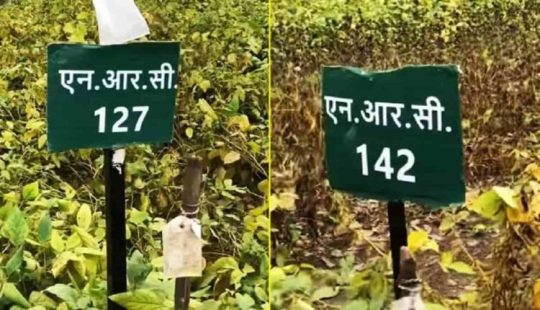
सोयाबीन की नई किस्में (New Soybean Varieties): देश के किसानों की हालत में सुधार, उनकी आय में वृद्धि के उद्देश्य से कृषि वैज्ञानिक आधुनिक तकनीक और फसलों की उन्नत किस्में लगातार विकसित करते रहे हैं। अभी हाल ही में अलग-अलग फसलों की 35 नई किस्मों की सौगात किसानों को दी गई। ये नई किस्में जलवायु अनुकूल और कुपोषण मुक्त भारत के अभियान को रफ़्तार देने में मददगार होंगी।
देश के अलग-अलग कृषि संस्थानों द्वारा ईज़ाद की गई इन किस्मों में सूखा प्रभावित क्षेत्र के लिए चने की नई किस्म, कम समय में तैयार होने वाली अरहर, जलवायु अनुकूल और रोग प्रतिरोधी धान की किस्में, पोषक तत्वों से भरपूर गेहूं, बाजरा, मक्का की किस्में शामिल हैं। इसके अलावा किनोवो, कुट्टू, विंग्डबीन और बाकला की उन्नत किस्में और उच्च गुणवत्ता वाले सरसों और सोयाबीन की प्रमुख किस्में की वैरायटी भी किसानों को समर्पित की गईं। इस लेख में आगे आप सोयाबीन की नई किस्मों की खासियत और उत्पादन क्षमता के बारे में जानेंगे।
सोयाबीन की जो नई किस्में आईं हैं, वो कई मायनों में ज़्यादा उन्नत हैं, जो इसकी खेती करने वाले किसानों को अच्छे उत्पादन के साथ-साथ गुणवत्ता भी देंगी। सोयाबीन प्रोटीन की मात्रा से भरपूर होता है। इसमें प्रोटीन की मात्रा लगभग 40 से 50 फ़ीसदी पाई जाती है। इसके नियमित सेवन से प्रोटीन की कमी से होने वाली बीमारियों से बचाव होता है। सोयाबीन के इन गुणों को देखते हुए ही लोगों के बीच इसकी अच्छी मांग रहती है। इस वजह से किसान अगर उन्नत किस्मों की खेती करेंगे तो उन्हें लाभ की संभावना ज़्यादा रहेगी।
भारतीय कृषि अनुसंधान परिषद- सोयाबीन अनुसंधान के भारतीय संस्थान इंदौर (ICAR-IISR) ने सोयाबीन की नई किस्मों को लेकर विस्तार से जानकारी दी है। आइए जानते हैं इन सोयाबीन की नई किस्मों के बारे में।
सोयाबीन किस्म एन. आर. सी. 128
सोयाबीन की एन. आर. सी. 128 किस्म (Soybean Varieties nrc 128) की खासियत है कि ज़्यादा पानी गिरने और जलभराव वाली स्थिति में भी ��स किस्म को नुकसान नहीं पहुंचता। इस किस्म में रोए हो��े हैं जिस कारण कीड़ों का प्रकोप कम होता है। ये किस्म बिहार, झारखंड, छत्तीसगढ़, ओडिशा और पश्चिम बंगाल के किसानों के लिए अच्छी है। साथ ही उत्तर मैदानी क्षेत्र पंजाब, हरियाणा और दिल्ली के लिए भी ये किस्म उपयुक्त है। पूर्वी क्षेत्र और उत्तर मैदानी क्षेत्र के किसानों को इस किस्म की खेती से फ़ायदा होगा। इस किस्म को विकसित करने का श्रेय डॉ. एम. शिवकुमार को जाता है।
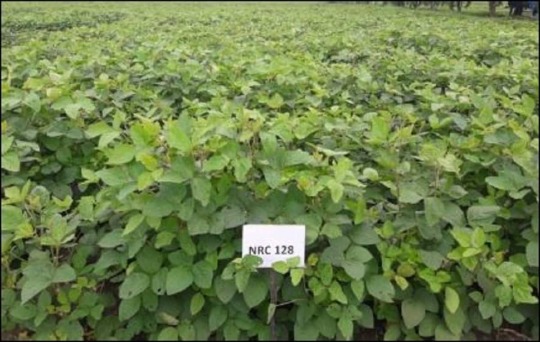
सोयाबीन किस्म एन. आर. सी. 127
सोयाबीन की किस्म एन. आर. सी. 127 खाद्य प्रोडक्ट बनाने के लिए बेहद उपयुक्त है। अन्य किस्मों को जहां इस्तेमाल से पहले उबालना पड़ता है। ये किस्म कड़वा मुक्त होने के कारण इसे खाया जा सकता है। ये किस्म 110 दिनों में पककर तैयार हो जाती है। ये किस्म मध्य प्रदेश, गुजरात और महाराष्ट्र के लिए उपयुक्त है।

सोयाबीन किस्म एन. आर. सी. 130
एन. आर. सी. 130 बहुत ही कम समय में पकने वाली किस्म है। जो किसान एक साल में अलग-अलग तीन फसलें लगाना चाहते हैं, उन किसानों के लिए ये किस्म पहली पसंद हो सकती है। इंदौर स्थित सोयाबीन अनुसंधान के भारतीय संस्थान के प्रधान वैज्ञानिक संजय गुप्ता ने इस किस्म को विकसित किया है।

और पढ़ें......
#icar#indian institute of soybean research indore#new variety of soybean#soybean farming#soybean variety#सोयाबीन#सोयाबीन किस्म#सोयाबीन की नई किस्म
0 notes
Text
you'll don't even know how deep i am in bean wikipedia right now
5 notes
·
View notes
Link
1 note
·
View note
Text
By combining food-bearing trees and shrubs with poultry production, Haslett-Marroquin and his peers are practicing what is known as agroforestry — an ancient practice that intertwines annual and perennial agriculture. Other forms include alley cropping, in which annual crops including grains, legumes, and vegetables grow between rows of food-bearing trees, and silvopasture, which features cattle munching grass between the rows. Agroforestry was largely abandoned in the United States after the nation’s westward expansion in the 19th century. In the 2022 Agricultural Census, just 1.7 percent of U.S. farmers reported integrating trees into crop and livestock operations. But it’s widely practiced across the globe, particularly in Southeast Asia and Central and South America. According to the U.N. Food and Agriculture Organization, 43 percent of all agricultural land globally includes agroforestry features. Bringing trees to the region now known as the Corn Belt, known for its industrial-scale agriculture and largely devoid of perennial crops, might seem like the height of folly. On closer inspection, however, agroforestry systems like Haslett-Marroquin’s might be a crucial strategy for both preserving and revitalizing one of the globe’s most important farming regions. And while the corn-soybean duopoly that holds sway in the U.S. heartland produces mainly feed for livestock and ethanol, agroforestry can deliver a broader variety of nutrient-dense foods, like nuts and fruit, even as it diversifies farmer income away from the volatile global livestock-feed market.
[...]
Trees actually have a much longer and more robust history in the Midwestern landscape than do annual crops. Think of the Midwestern countryside before U.S. settlers arrived, and you might picture lush grasses and flowers swaying in the wind. That vision is largely accurate, but it’s incomplete. Amid the tall-grass prairies and wetlands, oak trees once dotted landscapes from the shores of Lake Michigan through swathes of present-day Indiana, Illinois, Iowa, and Missouri, clear down to the Mexican border. These trees didn’t clump together in dense forests with closed canopies but rather in what ecologists call savannas — patches of grassland interspersed with oaks. Within these oak savannas, which were interlaced with prairies, tree crowns covered between 10 percent and 30 percent of the ground. They were essentially a transition between the tight deciduous forests of the East and the fully open grasslands further west. And in the region where Haslett-Marroquin farms — part of the so-called Driftless Area, which was never glaciated — trees proliferated even more intensely. In pre-settlement times, according to a 2014 analysis coauthored by Iowa State University ecologist Lisa Schulte Moore, closed-canopy forests of oaks, sugar maples, and other species covered 15.3 percent of the area, and woodlands (low-density forests) took up another 8.6 percent. Prairies — the ecosystem we readily imagine — composed just 6.9 percent. Oak savannas made up the rest.
10 September 2024
94 notes
·
View notes
Note
Farm au!!! Tony and Stephen are married and have been for years (like old bickering couple but still kiss like teenagers). A few years ago they hired Peter to work the farm, but now he is pretty much their adopted son😌😌
Steve and Bucky also work for them. One or both get their eyes on Peter mayhaps?👀👀 - @professional-benaddict 💗💗
Hi Rafni!! @professional-benaddict Hope you like this!
**************************************************************
" Aw come on guys! I just got back! Give me a day or two to adjust!"
Peter covers his eyes as he moves to go get the basket on the kitchen counter that is used to hold the fresh eggs.
Tony laughs and tosses a pillow over at Peter. He sits up from his spot on the couch where Stephen and him were making out heavily. They had gotten used to Peter not being around, though this still happened when he was before, but they 'tried' to make sure they were fairly descent.
"Tough luck Kid! Now get out of the house! While your out stop and introduce yourself to Steve and Bucky."
Peter shakes his head and laughs, picking up the tossed pillow and throwing it back lightly, hitting Stephen.
"Hey!"
"See you guys later! Gonna feed the chickens and get the eggs and check in on Karen!"
Stephen grumbles to Tony as he pulls him back closer.
" Can't believe you let him name that horse Karen."
Peter wondered away from the main house before heading toward the large chicken coup. The coup was situated next to the smaller house on the property. When Stephen and Tony bought the farm, it was a bit of a retirement project for them both.
They had a handful of horses, cows, some goats, and chickens. They had acres full of corn, soybeans, green beans and their own personal garden that everyone tends to. That one connected the two homes on the property, it had a small pumpkin patch, rows of tomatoes, cucumbers, carrots, radishes and turnips.
It was a bit much in the beginning, growing such a variety, but with their access to all the land they were able to divide it up in way to make it work for themselves. And as profits grew, they were able to hire in more help.
Ben Parker worked at the farm before Tony and Stephen bought it. He stayed working with the farm up until two years ago, his last trip into the city he had gotten into a wreck and passed away. They didn't expect Peter Parker to show up a month after, asking if he could work for them. They refused at first, knowing that the kid was in college, and they hadn't wanted him to give up on his dream to work at the farm.
But they both knew that May and Ben were on hard time, even with what they paid Ben. Between them taking in their nephew to raise, May's medical bills even with the insurance they offered. Money would be tight. But Tony was able to convince Peter to work during the summer months, winter break or whenever he was home. That way he could stay in school.
Peter was humming as he started gathering the eggs up out of the coup. The rest of the chickens were out of the coup eating at the feed he had just scattered out into their pen. Once he had checked all the trays for eggs, he covered the eggs he had in the basket up with a cloth.

He went to sit down to watch the hens and roosters run around, the head Rooster who he like to call 'Dodger' because of how much he runs away and dodges getting caught, got in his lap when he heard a voice call out, he looked up toward the smaller house on the property, it served as a guest house and as a place for workers to take a break.
"Hey Kid, What are you doing?"
Smiling, Peter gave an awkward wave.
"Hi! Mr. Stark said he hired new people to help. I'm Peter! Peter Parker"

The guy wiped a thing of sweat off his face with the towel he had around his neck before he nods towards Peter.
"Call me Bucky"
"Nice to meet ya Bucky"
Bucky offers him a small smile, and nods again.
"If your staying later, why don't you join Steve and I for dinner. Since your going to be around for a bit."
"Oh! Yes I mean sure.That sounds great"
"See you then Doll"
It was about an hour later when Peter was heading back with Karen to bring her back to the barn for the evening when he saw someone sitting outside with a couple of the horses.
"Hey! You must be Steve! I'm Peter."
Steve looked up startled out of his thoughts before he offered Peter a smile. Standing up and giving Peter a firm handshake.


"Nice to meet you Peter, Tony talks about you often"
Peter laughs and rubs the back of his neck.
"Yeah? Hopefully good things. I'm just bringing in Karen, do you want me to help with Jarvis and Friday?"
"I got them, time I should get them in anyway."
And that is how when Peter knocked on the door of the guest house, both Steve and Bucky were there, trying to open the door for him first.
#writing prompt#winterspider#spidershield#winterspidershield#winterspiderpurrs#peter parker x bucky barnes#shieldspider#thanks for the ask!#prompt answered
42 notes
·
View notes
Note
AITA for possibly causing someone to potentially break into an allergic reaction or maybe break religious dietary restrictions?
I work part time as a cashier at a convenience store in an east asian country.
Today a customer came up with a cup of instant ramen. He told me he was looking for a product with no meat in it, and asked me if the ramen had any meat in it. He was having trouble reading the label because he didn't speak the language.
I looked at the ingredients list and told him, "it has chicken in it", and he said "oh, chicken's fine, I'll take it."
However, the whole conversation was in English which wasn't either of us's first language, and I forgot to mention that the ramen was processed in a facility that also processes pork (and soybeans, and a variety of other products).
By the time I remembered I should probably mention that, he was already gone, and now I feel awful about it.
It probably wasn't an allergy thing, because most people who have an allergy severe enough that trace amounts matter usually always specify it, but if it was a religious thing, and he came from a majorly muslim or jewish country, he might not have been aware that a product that doesn't contain a certain type of meat could still be produced in a factory that does handle that kind of meat.
Or maybe none of this applies, and I'm just catastrophizing about it? (I have ocd so I tend to do that.)
So, AITA?
What are these acronyms?
89 notes
·
View notes
Note
Hiya! Hope it’s okay to ask, but what were your kind of first steps to living in a more solar punk way?
Hi! Absolutely ok to ask, I love talking to people about this.
I can probably date my Solarpunk awakening, if you want to use the term, to a variety of points, but in the past few years due to both growing eco-anxiety and a new connection with nature (moved out of the city into the country) I became more concerned with the environment and this led me to give up flying and start educating myself on solarpunk topics through books and podcasts. Living with my parents, who have more disposable income than me, helped me see what it was like to be able to purchase organic and plastic-free food. Living rurally meant we got to know our neighbours. When our house flooded, they were the ones bailing it out with buckets beside us at 1am, up to our ankles in cold, dirty water. I learned a lot about community. I started foraging for snacks and treats (hello blackberries are delicious). I got interested in the ecological elements of paganism.
Later on I started incorporating more plant-rich food into my diet and getting interested in slow travel, rewilding, urban planning, etc. Then I started going to XR meetings, which led me to getting involved in (non-arrestable in my case) direct action. I joined some gardening volunteers which encouraged me to start trying to grow my own food at home. I decided to commit to not learning to drive or owning a car.
However, I’d actually say I’d been doing solarpunk stuff earlier than this without knowing it - seeking out positive news stories, attending protests, organising in my community (I was active in my school’s LGBT scene and ran several campaigns about it at uni), learning about indigenous cultures, telling stories. All of these things are solarpunk too.
But the single biggest thing that has helped me to be more solarpunk is changing the way I see the world, and for this the writings of Robin Wall Kimmerer have been hugely influential, along with a bunch of different writers that I can’t list all of here. But unlearning the idea that I am alone in a lifeless inanimate world has been HUGE for me. Today I thanked every element that made up my meal, from the rice in my noodles to mycoprotein that grew my meat substitute to the soybeans that made the sauce, the steel in my pan and the sunlight that powered the electricity that heated my induction hob. I walked along a river and said hello to geese. I noticed each plant and knew the names of many of them. I called my grandmother and tried to really listen as she narrated her experiences of the day to me, even though she can be difficult. Relationality has been the greatest aspect of my solarpunk work, learning to see myself as utterly interconnected with everything and everyone else, to remember that my very atoms were once compressed together with all the other atoms when this expanding universe first began. So a lot of it is about changing your thoughts, though it should also be backed up by action too.
Hope some of this helps!
#solarpunk#hopepunk#environmentalism#cottagepunk#social justice#community#optimism#bright future#climate justice#tidalpunk
73 notes
·
View notes
Text
According to a recent survey, many people are looking for ways to get ahead in life. Whether it’s taking a new job, starting a business, or just improving their quality of life, the search for success is on. But what if there was a simple way to get ahead that you may have overlooked?
Enter hoisin sauce. This Chinese condiment is made from fermented soybeans, garlic, chili peppers, and other spices. It has a sweet, savory, and slightly spicy flavor that goes great with a variety of dishes.
But it turns out that hoisin sauce has more to offer than just flavor. According to research, the combination of ingredients in hoisin sauce can actually help you get ahead in life.
First, the garlic in hoisin sauce can help boost your energy levels. This can help you get up earlier, work longer, and be more productive throughout the day.
Second, the chili peppers in hoisin sauce can help boost your metabolism. This can help you burn more calories throughout the day and can help you lose weight and stay in shape.
Finally, the soybeans in hoisin sauce can help reduce inflammation. This can help reduce the risk of chronic diseases, such as heart disease and diabetes.
So if you’re looking for ways to get ahead in life, you may want to consider adding hoisin sauce to your diet. It can boost your energy levels, help you lose weight, and reduce your risk of chronic diseases. Who knows, it may just be the secret ingredient to success.
241 notes
·
View notes
Text
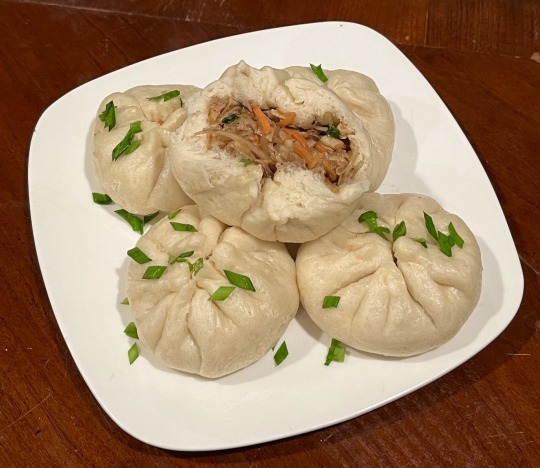
[ID: Five large, enclosed bao piled on a plate. The topmost bao has been opened to show a bread-like dough texture and a vegetable filling. The bao are garnished with chopped chives. End ID]
Bánh bao chay (Vietnamese vegetable dumplings)
Bánh bao are an iteration on the Chinese da bao (大包) brought to Vietnam by Cantonese immigrants. Like da bao, bánh bao are commonly filled with some combination of minced meat, Chinese sausage, and hard-boiled eggs; however, some versions of bánh bao are also made with Vietnamese vegetables, herbs, and flavorings. Vegetarian bánh bao (bánh bao chay) may have no filling, a filling consisting of a variety of vegetables, or a filling of sweetened beans or sweet potato.
This recipe combines Vietnamese vegetables, herbs, spices, and sauces with Vietnamese meat substitutes to make a well-rounded filling that's equal parts umami and fresh. The yeasted, enriched dough is tasty, fluffy, and light, but still has enough structure to hold up against the filling.
Recipe under the cut!
Patreon | Tip jar
Makes 16-20; serves 6.
Ingredients:
For the dough:
4 cups + 2 Tbsp (500g) all-purpose flour
2 tsp (7g) active dry yeast
7 Tbsp (90g) granulated sugar
1/2 tsp salt
2 tsp (10g) baking powder (optional)
2 Tbsp (16g) cornstarch (optional)
1 - 1 1/4 cup (135-295 mL) lukewarm soy or oat milk, or water
1 Tbsp cooking oil
The basic components of this dough are flour, yeast, sugar, salt, oil, and milk. The baking powder is added to help with leavening; the cornstarch works to create a light, fluffy dough that will not become soggy when filling is added.
For the filling:
1 large carrot (100g)
4-inch piece (120g) cassava root / yuca
1 cup (100g) shiitake or wood-ear mushrooms, diced
4 large pieces (50g) sườn non chay, or 1/2 cup diced or crumbled chả lụa chay
1/2 cup water + 1/2 tsp vegetarian 'chicken' broth concentrate (optional)
50g tofu skin (đậu hủ ky)
1 red onion, minced
5 cloves garlic, chopped
4-5 chives or scallions, finely chopped
1 tsp freshly ground black pepper
1/2 tsp sugar, or to taste
1/2 tsp salt, or to taste
2 tsp bột nêm chay, ground to a powder (optional)
1 1/2 tsp fermented bean paste + 1/2 tsp light soy sauce (or 2 tsp vegetarian fish sauce)
2 tsp vegetarian oyster sauce
1/4 cup soybean oil, peanut oil, or other cooking oil, divided
Sườn non chay (roughly, “vegetarian ribs”) is a meat replacement made of textured soy protein. It may be found in bags online or in the pantry / dried goods section at your local Asian grocery store—the bags will be labelled “sườn non chay” as well as “vegan meat slice,” “textured soy bean protein,” “vegetarian food,” or “vegan food.” Most sườn non chay are large and pale in color, but they sometimes come in "beef" or "pork" styles—the difference is not the flavoring but rather the size, shape, and coloring of the pieces. In my experience, the "beef" ones are more darkly colored, and both "beef" and "pork" styles are smaller in size and thinner in shape than the non-specific ones, which I often use to replace chicken.
Chả lụa chay is a vegetarian version of a Vietnamese pork sausage. It can be found in the form of a large loaf in the refrigerator section of a Vietnamese or Asian grocery store. It will be labelled "chả lụa chay" or "gio lụa chay," as well as "vegetarian pork roll," "wheat meat," or "vegetarian food."
Đậu hủ ky, or tofu skin, is prepared by taking the film off of a batch of tofu as it sets. Tofu skin may be purchased fresh or dried, in sheets or in sticks: for the purposes of this recipe, any kind will work! Chinese tofu skin produced for sale abroad may be labelled "dried beancurd sticks."
Bột nêm is a Vietnamese seasoning sold in powder or granule form. Vegetarian ("chay") versions of the seasoning may contain shiitake mushroom, lotus seeds, carrots, tomatoes, and kohlrabi, as well as salt and MSG. It can be purchased in pouches or boxes from an Asian grocery store, or you can use any other vegetable stock powder.
Fish sauce and oyster sauce are common inclusions in pork fillings for bánh bao but are often simply omitted from vegetarian ones. I've used vegetarian substitutes for these ingredients—if you don't have vegetarian imitation fish or oyster sauce, just increase the amount of salt, sugar, and bột nêm to taste.
Instructions:
For the dough:
1. Heat 1 cup (135mL) non-dairy milk to lukewarm in a saucepan or in the microwave. Stir in the yeast to dissolve. if you’re not sure your yeast is alive, proof it by allowing to stand for 10 minutes—it should foam.
2. Add the baking powder, sugar, and salt and whisk to dissolve.
3. In a large bowl, whisk together flour and cornstarch. Pour in the milk mixture and mix well to combine. Add additional milk 1 tsp at a time if it remains too dry to combine. The dough should be slightly tacky but not sticky.
3. Add oil and knead by hand until dough is smooth and elastic, about 10 minutes. Cover with plastic wrap and allow to rise in a warm place for about 3 hours until doubled in size. If you live in a cold climate and don't have a proofing drawer, heat your oven on the lowest setting for a few minutes, turn it off, and then proof the dough in the oven.
For the filling:
1. Prepare the proteins. Soak the tofu skin (if you're using dried) and sườn non chay in cool water for about half an hour until rehydrated (or simmer them for a shorter amount of time). They are fully hydrated once flexible and a couple shades lighter. Gently squeeze the water out. Dice tofu skin; rip sườn non chay into small pieces lengthwise and then dice widthwise.
2. Prepare the vegetables. Peel cassava root and carrot. Cut both into a fine julienne, or grate them. Dice the mushrooms; mince the red onion; chop the garlic.

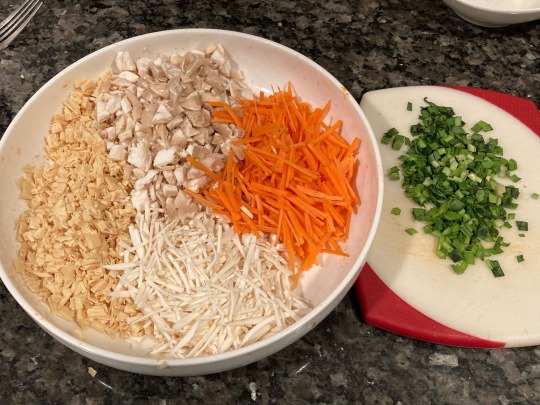
3. Cook the filling. Heat oil in a large skillet on medium. Add the garlic and sauté until fragrant.
4. Add the red onion and continue to sauté until fragrant and slightly softened. Add black pepper, bột nêm, and salt and allow to cook another 30 seconds.
5. Add carrot, cassava, mushrooms, chả lụa chay (if using), and tofu skin and stir to combine. Reduce heat to low and cook, stirring often, until tender. Remove from pan.
6. If using sườn non chay: in the same pan, fry sườn non chay in 3 Tbsp of cooking oil on medium until they’ve absorbed the oil. Whisk 'chicken' stock concentrate into a small amount of hot water, then add the stock into the pan. Cook until mostly dry.
Soaking in water, deep frying in oil, then simmering in a flavored broth is the typical Vietnamese preparation of sườn non chay. The simmering in stock could potentially be skipped if you're including vegetarian oyster and/or fish sauce, but personally I find that dried soy products benefit from being soaked or simmered in something other than water.
7. Mix sườn non chay in with other filling ingredients, salt, sugar, sauces, and chives.
To assemble:
1. Turn dough out from its proofing bowl and gently divide into two even parts. Cover the half you're not using and gently roll the other out into a log of even width. Use a dough cutter or sharp knife to divide the log into 8 or 10 even pieces.
2. Place each disc of dough on its side and roll it out into a circle about 5" (13cm) in diameter. The edges of the circle should be much thinner than the center, since the edges will be bundled up and folded together.
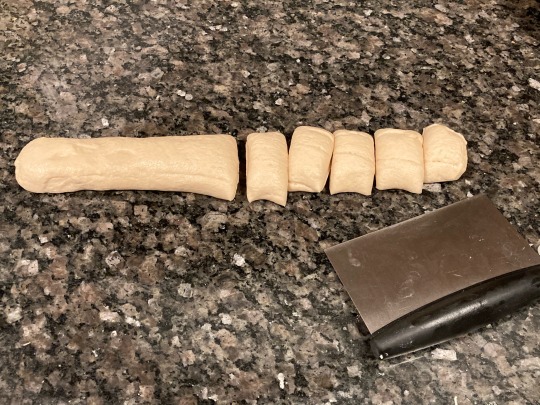
3. The folding method is the same as for baozi and momos. Hold a wrapper in the palm of your non-dominant hand and add a couple tablespoons of filling (if you’re not experienced with making dumplings, it may be easier to add less). While pressing the filling down with your non-dominant thumb, use your other hand to pinch pleated folds in the dough all the way around the circle of the wrapper. Remove your thumb and make one last fold to close the bao. Pinch firmly at the place where all the pleats come together (where the drawstring would be if it were a drawstring pouch) and give a small twist to seal.
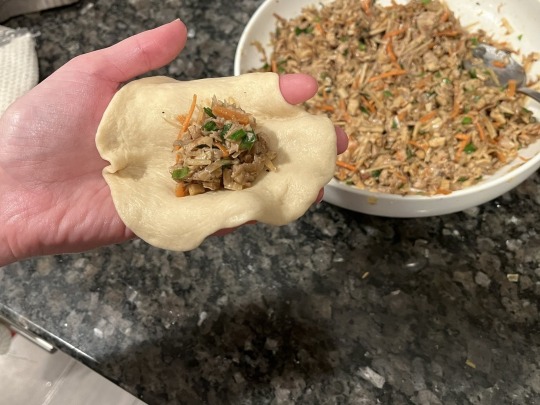
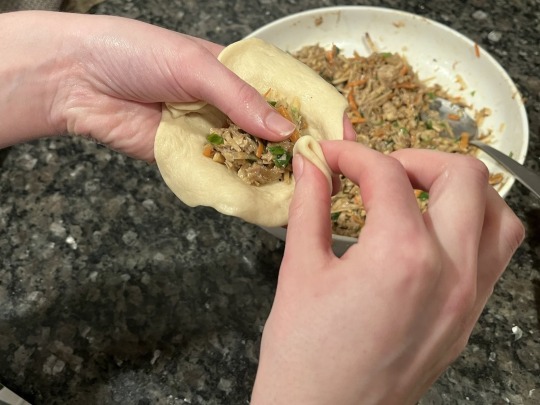
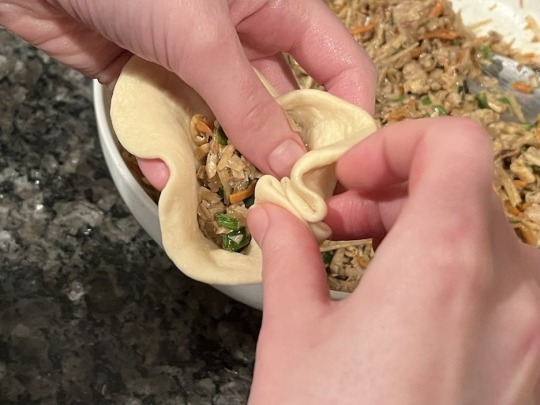


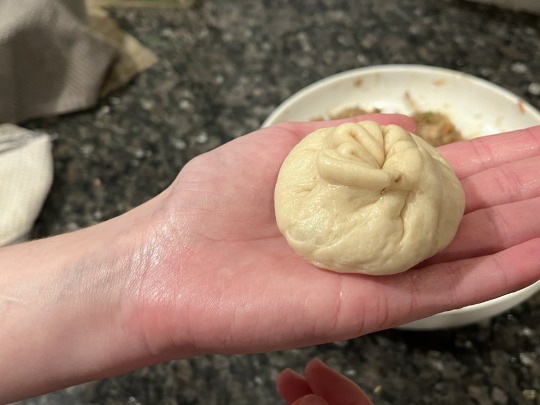
4. Set each finished bao on a small square of parchment paper on a baking sheet or in a steamer and lightly cover with plastic wrap or a light kitchen towel. Continue folding until you have formed all of the bao.
To steam:
1. Place a bamboo steamer in the bottom of a wok or large pot, and fill the wok with enough cool water to cover the bottom rim of the steamer by ½". If you've added baking powder to your dough, you may add a splash of vinegar to the water to help neutralise the dough's pH and combat yellowing of the dough.
If you’re using a metal steamer, tie a kitchen towel around its lid to prevent condensation from dipping back down onto the dumplings. Carefully place the bao, along with their parchment paper squares, into the steamer, leaving an inch or so between each one. They will expand as they steam!
If you don’t have a steamer, place a small bowl in the bottom of a wok or large, deep pan or pot. Place the dumplings, with their parchment paper squares, on a plate and place the plate on top of the bowl–the plate should fit inside your pot. Make sure that you can cover the plate and dumplings with a lid. If your lid is domed, there is no need for a kitchen towel, since the condensation will run down towards the outer rim. If your lid is flat, tie a tea towel around it just as you would with a metal steamer. Fill your cooking vessel with 2 or so centimeters of cool water.
2. Raise the heat to high and allow the water to come to a boil. Once boiling, lower the heat to medium-low and cover your steamer or pot. Steam the dumplings for about 8 minutes, until the dough is tender and cooked through. Keep finished bao warm in a covered casserole dish in an oven on low while you steam the others.
#vegetarian recipes#recipes#vegan recipes#Vietnamese#dumplings#carrots#cassava root#tofu skin#mushrooms#sườn non chay#chả lụa chay#fish sauce#chives
281 notes
·
View notes
Text
On the Skidelsky/Fuller post I reblogged, I absolutely welcome automation given the following criteria:
1. The output is identical or, holistically, more positive than human labor output
2. This automation occurs within an economic system in which GDP growth (or similarly fraught metrics) is not the primary objective
3. The automation aids the sustainability of nature and humanity
The USA's agriculture industry is a wonderful example of modern automation failing all three of these criteria. Throughout the entire industrial revolution, agriculture has trended away from being a society-wide confederation of family/community-scale, labor-intensive smallholdings to our current reality of a small number of monolithic industrial farms that are maintained by astoundingly few people who operate increasingly complex and expensive equipment.
Our massive-scale industrial farms are fantastic at what they were designed for; they grow as much of a staple crop as possible without regard to human or environmental health, doing so using minimal labor. Fundamentally, it is an extractive industry. Fossil fuels are extracted to power the machinery, processing, and logistics systems. Nutrients are extracted from the soil to the point that crop growth can only be sustained with heavy amounts of industrial fertilizer input. Entire ecosystems are sacrificed when forests are cleared to be exploited and repeatedly battered with pesticides. This is all primarily to produce soybeans, feed corn, and cotton to then process into products like factory farm livestock feed-slurry, corn syrup, junk food, and sweatshop garments. Secondarily, it is to produce flavorless, nutrition-void produce that can be sold year-round. Consistency is the goal, although one may find that nature itself is curiously inconsistent.
This case study of automation's failings can be traced back to a few major factors:
1. Old-style agriculture work is disagreeable to the USA's perverted fascination for infinite GDP growth; each farm laborer that can be replaced by a machine is a potential worker that could move into a city (or suburb) and put in the same amount of hours at a higher-dollar job. It's just opportunity cost, and this is more-or-less what Skidelsky and Fuller find offensive about our current labor zeitgeist; instead of the now-jobless laborers being free to pursue their interests, they are instead shoehorned into some shitty desk job that produces a relatively greater amount of money to be leeched by executives and shareholders -- this is "more productive" to our economy on the basis of GDP growth and thus must be prioritized over agricultural labor.
2. Industrial approaches to large-scale agriculture are inherently reductive to an extreme extent. Nature is far more complex than Liebig or any other enlightenment thinker ever imagined. Industrialization is great at making cars or computer chips or Gucci jackets or whatever, as these are things that can be standardized with relative ease. Nature cannot be tamed and standardized in a similar way; ecosystems, particularly soil ecosystems, can vary massively even in small areas of the same climate type. Our agriculture systems cope with this simply by ignoring such factors and reducing crop growth to a formula. In X region, plant Y variety of Z crop on A date and apply a regimen of B-type fertilizer and C-type pesticide on D date etc etc. This is the most egregious reduction of something in all of history.
Liebig's reduction of agriculture to the NPK model, just three elements, is good for achieving the singular goal of making your plant of choice come out of the ground, but it ignores all the nuance of soil, climate, and evolution. The other factors don't matter. Modern lab-designed fertilizers often feature a plethora of additional micronutrients, but the goal is still to produce a healthy crop, not healthy soil. Soil itself is an organism, it is something that must be nurtured to be healthy; industrial pesticide/fertilizer regimens are to the soil as feed slurry/antibiotic regimens are to factory farm animals.
Natural processes are, itself, the greatest form of automation for agriculture. Plants and animals that are native to a region have evolved to grow there regardless of human intervention. It is our disruption of these processes that forces agriculture to be labor/resource-intensive. This isn't to say that everyone must immediately abandon all non-native foods and adopt a primarily undomesticated Ötzi diet, but instead, it's worth considering that the complexity of modern technology is not even close to being at parity with the complexity of nature; nature has a several billion year head start. There is no way to flawlessly "tame" it with technological solutions, but a comfortable middle ground can certainly be found.
If sustainable, climate-friendly food production is the primary objective of agriculture, this is far more easily achieved by small, ecology-considerate farms than massive, largely automated industrial farms. A healthy soil ecosystem will aid in growth, flavor, nutrition, and, (quite importantly) carbon sequestration. Broadforking, shoveling, and wheelbarrow-pushing is absolutely more labor intensive than sitting back in a huge John Deere tractor with GPS-based autopiloting features, but the extra labor can turn a woefully extractive process into one that is instead highly regenerative.
20 notes
·
View notes
Text
A graduate cohort and friend happens to be a vegan and posts consistently on LinkedIn. However, I answered them that such a dietary lifestyle IS NOT feasible for many of us who suffer from chronic pain, or chronic illness, or chronic disorders, and often, all of the above.
Here was my DM reply to that friend, whom I must add, DID NOT respond. So... Below is my answer:
It isn't just that simple. While I understand what you're saying, there are folks like me with chronic illnesses and food allergies. And lactose intolerant folks have found that goat's milk is more tolerable for their digestion than cow's milk. While I respect veganism and vegetarianism whether for ethical, religious, or health reasons, there's a sizeable amount of folks with chronic conditions and food allergies who couldn't consume most of the foods listed here. As a matter of fact, they have learned that soy and other nut-based foods even exacerbate those chronic health disorders. A variety of nuts, tree nuts, and seeds will send me to the hospital and soybeans are as dangerous to me with aggravating my chronic pain. Peanuts, almonds, and cashews can send me into shock.😅 And I know more folks offline and on who are allergic to and can get even more chronically ill from nearly all these listed. There are so many folks that are not able to be vegetarian or vegan for a host of reasons.
#chronic illness#chronic pain#chronically ill#chronic fatigue#disabled#veganism#food allergies#food intolerance
7 notes
·
View notes
Text
Fouke Monster
the Fouke Monster also known as the Boggy Creek Monster and the Swamp Stalker, is purported to be an ape-like creature, similar to descriptions of Bigfoot, that was allegedly sighted in the rural town of Fouke, Arkansas during the early 1970s. The creature was alleged to have attacked a local family.

The creature was named by journalist Jim Powell, who reported on it for the Texarkana Gazette and the Texarkana Daily News.
Various reports between 1971 and 1974 described it as being a large, bipedal creature covered in long dark hair. It was estimated to be about 7 feet (2 m) tall with a weight of 250–300 pounds (110–140 kg). Later reports claimed that it was far larger, with one witness describing it as 10 feet (3 m) tall, with an estimated weight of 800 pounds (360 kg). Some accounts describe the Fouke Monster as running swiftly with a galloping gait and swinging its arms in a fashion similar to a monkey. Reports also describe it as having a terrible odor, the odor being described as a combination of a skunk and a wet dog, and as having bright red eyes about the size of silver dollars.
A variety of tracks and claw marks have been discovered which are claimed to belong to the creature. One set of foot prints reportedly measured 17 inches (43 cm) in length and 7 inches (18 cm) wide, while another appeared to show feet that only possessed three toes.
Prior to the 20th century, several alleged sightings in the general area related to a large, hairy creature circulated in an 1851 report in the Memphis Enquirer, and an 1856 report in the Caddo Gazette.
Local residents claim that the creature had roamed the area since 1964, but those sightings had not been reported. Local folklore also holds that the creature can be further traced back to sightings in 1946. Most early sightings were allegedly in the region of Jonesville as the creature was known as the "Jonesville Monster" during this period.
In 1955 the creature was allegedly spotted by a 14-year-old boy who described it as having reddish brown hair, sniffing the air, and not reacting when it was fired upon with birdshot. Investigator Joe Nickell observed that the description was consistent with a misidentified black bear (Ursus americanus).
The Fouke Monster first made local headlines in 1971, when it was reported to have attacked the home of Bobby and Elizabeth Ford on May 2, 1971.
According to Elizabeth Ford, the creature, which she initially thought was a bear, reached through a screen window that night while she was sleeping on a couch. It was chased away by her husband and his brother Don. During the alleged encounter, the Fords fired several gun shots at the creature and believed that they had hit it, though no traces of blood were found. An extensive search of the area failed to locate the creature, but three-toed footprints were found close to the house, as well as scratch marks on the porch and damage to a window and the house's siding. According to the Fords, they had heard something moving around outside late at night several nights prior but, having lived in the house for less than a week, had never encountered the creature before.
The creature was allegedly sighted again on May 23, 1971, when three people, D. C. Woods, Jr., Wilma Woods, and Mrs. R. H. Sedgass, reported seeing an ape-like creature crossing U.S. Highway 71.[19] More sightings reports were made over the following months by local residents and tourists, who found additional footprints. The best known footprints were found in a soybean field belonging to local filling station owner Scott Keith. They were scrutinized by game warden Carl Galyon, who was unable to confirm their authenticity. Like the Ford prints, they appeared to indicate that the creature had only three toes.
The incident began to attract substantial interest after news spread about the Ford sighting. The Little Rock, Arkansas, radio station KAAY posted a $1,090 bounty on the creature. Several attempts were made to track the creature with dogs, but they were unable to follow its scent. When hunters began to take interest in the Fouke Monster, Miller County Sheriff Leslie Greer was forced to put a temporary "no guns" policy in place in order to preserve public safety. In 1971, three people were fined $59 each "for filing a fraudulent monster report."
After an initial surge of attention, public interest in the creature decreased until it gained national recognition in 1973 when Charles B. Pierce released a docudrama horror film about the creature in 1972, The Legend of Boggy Creek.
By late 1974, interest had waned again and sightings all but stopped; only to begin again in March 1978 when tracks were reportedly found by two brothers prospecting in Russellville, Arkansas. There were also sightings in Center Ridge, Arkansas. On June 26 of that same year, a sighting was reported in Crossett, Arkansas. During this period the creature was blamed for missing livestock and attacks on several dogs.
Since the initial clusters of sightings during the 1970s, there have been sporadic reports of the creature. In 1991, the creature was reportedly seen jumping from a bridge. There were forty reported sightings in 1997 and, in 1998, the creature was reportedly sighted in a dry creek bed 5 miles (8 km) south of Fouke.
33 notes
·
View notes
Text
Global Food Prices Risk Spiking on Worst-Ever Drought in Brazil
Long periods without rainfall are becoming the norm — and the world’s bread basket is a microcosm of how climate change is turning lives and whole economies upside down.

For six months, not a drop of rain fell on José Orlando Cintra Filho’s coffee crops.
The white flowers that typically inspire hope of a good arabica harvest — the bean variety favored by chains including Starbucks Corp. — still haven’t blossomed. Instead, the trees withered. Cintra Filho, knowing he didn’t have enough water in his reservoirs, stopped irrigating his farms and trimmed some branches earlier than usual. Next year’s harvest is already shrinking.
“I’ve been in coffee for 36 years and I have never been through this,” he said, hectares of parched trees surrounding him in a major coffee producing area known as Mogiana Paulista.
The worst drought in Brazil’s history is doing more than jeopardizing coffee, sugar and soybean crops. Dead vegetation is giving way to fires, sending greenhouse gases into the atmosphere and disappearing more of the Amazon rainforest. Key rivers, responsible for transporting a third of the nation’s prized soy crop, are drying out. Utility costs are up given that the country gets two-thirds of its energy from hydropower.
And as one the world’s largest crop exporters, any trouble in Brazil’s agriculture business has knock-on effects for food prices around the world.
Continue reading.
#brazil#brazilian politics#politics#environmental justice#economy#environmentalism#climate change#farming#image description in alt#mod nise da silveira
9 notes
·
View notes
Link
1 note
·
View note
Text
For All Seasons
Yesterday, I opted to start propagating my basil plants. I only bought two, you see (I don't start from seed because cats and indoor gardening are a bad combination). Basil propagates well - you cut a few stems of the plant off, strip most of the leaves, and put it in water. The stems will grow roots and after a week or two you plant those, let them grow into full plants, and by the end of summer those two plants are a fuckton of basil.
Now, you'll note the part where you're stripping basil leaves? This yields, well, basil leaves. I mostly have basil to make pesto, but I do use it for other stuff. Not, however, two or so cups at a time which is what I get when I go a-propagating. But I don't like to waste food, so... well, I either freeze it or - as I did this time - I put them in the food dehydrator (shoutout to @antarctica-starts-here, @fera-angelus, and their other partner for the gift which I use an awful lot).
There's a certain longitudinal aspect to all this. I bought basil plants in spring (and would have started them from seed even earlier if that were practical) with the intent to propagate them so that by late summer I have enough basil to make a year's worth of pesto which I will freeze. Along the way I am also preserving leaves in order to use for other purposes. I'm trimming and drying my other herbs along the way, too.
What I'm contemplating is, historically this would be an entire lifestyle. I would be constantly engaging in this cycle of planning, maintaining, harvesting, and preserving. It would be multiple cycles which feed into one another and define my entire life.
The first part to recognize is, prior to the 20th century, a successful society had only about 50% of its population engaged in food production. In the 17th century, if you passed 100 people on the street, there were another 100 people too busy farming, hunting, or fishing to be walking around in some city. And that's what a successful society was like. Less successful ones could have as much as 90% of their population engaged in food production. That means food was one of the most valuable commodities. You did not want to waste it, ever. It pretty much always made sense to do stuff to prevent food waste and increase food production. And many of our foodstuffs have their origin in preventing waste.
So let's go back to our farmer.
Well, let me go a bit forward. Modern farms tend to be monocultures: enormous properties with hundreds of acres of corn or wheat or soy; some specialize in fruits or vegetables; or they do specifically livestock for example. They're mostly just a few things. (this is not to say all modern farms are like this; I'm simply referring to the majority). These tend to be very big, or at least larger than historical farms, they are specialists, and they are operated by relatively few people. The yield per person is considerable, but they do not produce a sufficient variety of food to live off of - try to eat nothing but corn and you WILL die. By virtue of their size, farmers who are not engaged directly in tending their crop spend their time otherwise maintaining the equipment or property: mending fences, working on the all-important tractor, &c.
Historically, farms were much more varied but also smaller, and of course with less equipment and more people. The variety is significant, though. You don't want to be growing Just One Thing. Farms were at least partially self-sufficient: you're growing the grains, fruits, and vegetables to feed everyone on the farm and have enough left over to sell in order to pay whatever taxes, and buy whatever you needed.
This approach meant you tried to have crops which grew and were harvested throughout the year: you didn't want to be trying to harvest all your soybeans while the crows are picking clean the corn, after all. And some of this could be astoundingly deterministic: there's a cultivar of corn which was grown specifically because it ripens before a particular beetle's breeding season and thus the crop is not ruined.
We're told that being a farmer was a lot of work. But we're seldom given a view of what that means. We get a vague notion of plowing and harvesting, but what comes in between?
It's plowing a different field to grow a different crop. Weeding the first field so that crop grows well. Harvesting herbs and drying them. Harvesting vegetables and pickling them. Hunting for meat and smoking it.
You're constantly planning for your next few steps. You get fruit pies when fruits are in season. You enjoy a tomato pie because you have tomatoes in abundance and you'd damned well better use them lest they rot. You throw the kitchen scraps to the pigs, who get nice and fat, and once they're big enough you slaughter them. You've got your chickens, and if a hen stops laying eggs, you roast it; if the rooster is too old you have coq au vin and get a new rooster.
It's a constant juggling act to make sure everything is used, because failing to turn the compost heap one year means less potatoes the next year and that means grumbling stomachs the next winter. The question of "What's for dinner?" doesn't mean "What do I feel like having" nor "What do I want to make?" but rather "What can I make with the food which exists right now?"
12 notes
·
View notes
Text
trying to get into natto tbh kind of disappointed was hoping for a much stronger flavor i think i may have accidentally bought a less strong variety as it was chopped up not whole beans but we shall see id wanted to try it for a long time cuz i love most fermented soybean products yes i do shell out for the more expensive aged doenjang at hmart and was imagining that but with less salt so its like edible undiluted but it was just kinda underwhelming flavor weird texture :(
4 notes
·
View notes